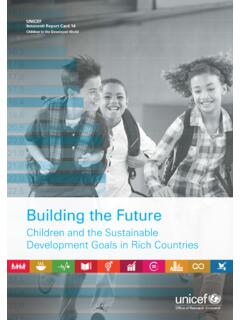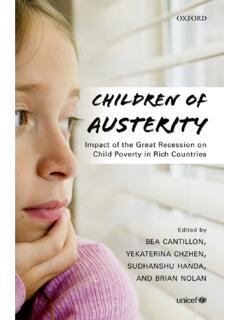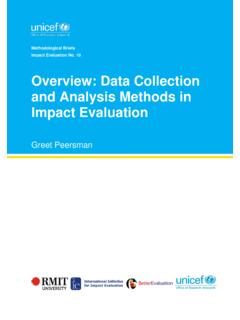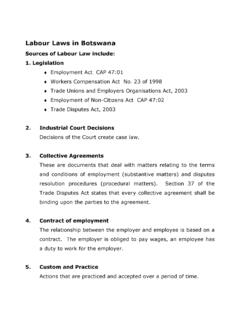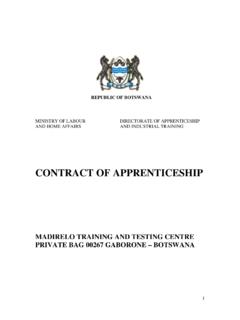Transcription of Chapter 6 Globalisation and Child Labour - UNICEF …
1 HARNESSING Globalisation FOR CHILDREN: A report to UNICEFC hapter 6 Globalisation and Child Labour *Alessandro Cigno, Furio C. Rosati and Lorenzo GuarcelloSummary. There is no empirical evidence that Globalisation increases Child Labour . Ifanything, Globalisation reduces Child Labour . In a country that starts out with a largelyuneducated workforce, Globalisation raises the wage rate of uneducated, relative toeducated workers. Unless the government takes steps to counter the reduction in theincentive to educate children, the net effect of Globalisation is likely to be an increasein Child Labour . By contrast, in developing countries that have spent sufficiently foreducation to have a relative large number of workers with at least a basic education, Globalisation raises the wage rate of educated, relative to uneducated workers.
2 In thesecountries, public intervention is needed not to raise the incentive for parents toeducate their children, but to loosen liquidity constraints. Developing countries canturn Globalisation into an opportunity to reduce Child Labour by spending more oneducation and public health. Developed countries can help them by financing thesepolicies, compensating them for short-term adverse effects, and stopping :D13, F12, I20, J13, J24, O15* This study presents the views of its author and not the official UNICEF position in this is Chapter 5 of the overall study Harnessing Globalisation for Children: a Report toUnicef edited by Giovanni Andrea 6: Globalisation AND Child LABOUR21. IntroductionEconomists have long been aware that international trade is beneficial on efficiencygrounds, but has strong re-distributive implications.
3 The Corn Laws , thatdepopulated the countryside in 18th Century England, and created the pre-conditionsfor the industrial revolution, are a prime example of what can happen when barriers totrade come down. A prime example of what can happen if barriers stay up is providedby the European Common Market s agricultural policy (CAP), part of the politicaldeal that permitted the West European integration to be set motion after the end ofWorld War II. By keeping internal farm prices systematically above world levels, anddumping excess production on to the world markets, the CAP, and similar policiescarried out by North American countries, contributed to the transformation ofsubsistence farmers in industrial workers (and shanty town dwellers) throughout thedeveloping world (Boserup 1981, Chapter 15).The question here is, given that there may be gainers and losers fromglobalisation, are children likely to be among the former, or among the latter?
4 Morespecifically, is further trade liberalisation and industrial integration on a world scalelikely to raise the number of children engaged in work activities? If the answer is yes,and given that Globalisation is unlikely to stop (because many gain from it), what canbe done to remove such a consequence? Section 2 examines the available 3 and 4 interpret it in the light of household economics and trade 5 discusses the policy Does Globalisation increase Child Labour ? Globalisation is the process by which an increasing share of world production istraded internationally, and the productive systems of different countries becomeincreasingly interdependent (on this see also Chapter 1 of this compilation). It startedsoon after the end of the second world conflict, but gathered momentum in the 1980s,as rapid progress in information technology compounded the effects of fallingtransport costs and trade liberalisation (Krugman, 1995).
5 It thus seems reasonable, intrying to understand the consequences of Globalisation , to look at what has happenedover the last couple of decades. Most of the existing analyses are concerned with theeffects of Globalisation on wages and employment in the developed world. Since ourconcern is Child Labour , and Child Labour is concentrated mainly in the developingworld,1 we focus on the experience of developing useful source of information are the World Bank s Development Indicators. Usingthese, and subsidiary information provided by Sachs and Warner (1995), weconstructed a World Panel, consisting of the data available on each developingcountry for the years 1980, 1990, 1995 and 1998. Since economic structure and 1 Though not on a comparable scale, Child Labour is becoming a problem also in developed , however, it is largely connected with clandestine immigration (an example is the illegalimportation of Chinese children to work in the Italian leather industry and rag trade).
6 One way oranother, the main source of Child workers is thus the developing Globalisation FOR CHILDREN: A report to UNICEF3economic policies differ substantially between Africa, Asia and Latin America, weshall look at each continental area separately, as well as at the developing world as measure of Child Labour that figures in the Development Indicators is theparticipation rate of individuals aged 10 to 14. The limitation of this measure is that itdoes not count children working at younger ages (the participation rate for the agegroup 6-10 is far from negligible)2, and children engaged in unofficial, especially ifillegal, work activities. It thus leaves out what are probably the most undesirableforms of Child work. In addition to this measure of Child Labour , we thus consider theprimary school non-attendance rate (the complement to unity of the primary netenrolment rate reported in the Development Indicators).
7 The problem with using thelatter as an indicator of Child Labour is that children not attending school are notnecessarily working (in the home or elsewhere).3 However, since children notattending school are more difficult to monitor by the authorities than children who do,and thus more exposed to the worst forms of abuse (from hazardous or very hardwork, to soldiering and prostitution),4 the non-attendance rate is at least a is generally assumed to be the main cause of Child Labour . Indeed, asFigures 2 a-c and 3 a-c show, there is a negative association between income andchild Labour . For similar levels of per-capita income, however, both our indicators ofchild Labour show very large variations. That may be partly due to the fact thatcountries with similar levels of per-capita income can have very different incomedistributions, but partly also to the effects of different 1a: Asia 2 Cf.
8 Cigno and Rosati (2000), Rosati (2000), Rosati and Tzannatos (2000), and the statistics availableat In a sample of Indian rural households, Cigno and Rosati (2000) find that the characteristics ofchildren reported by their parents as neither working nor attending school are very similar to those ofchildren reported as working full See Cigno, Rosati and Tzannatos (2001).MongoliaNepalBangladeshLao PDRM yanmarCambodiaTurkeyIndiaThailandSri LankaMalaysiaVietnamPhilippinesIndonesia China05101520253035404550657075808590951 00105 Enrollment rate, primaryChild labor 10-14 (% of age group) Chapter 6: Globalisation AND Child LABOUR4 Figure 1b: AfricaFigure 1c: Latin America and CaribbeanComorosGuinea-BTanzaniaChadTogo BeninGuineaMozambiqueMaliBurkina VerdeNamibiaMoroccoEgyptSwazilandMalawiA ngolaCote d'IvoireAlgeriaMauritiusZimbabweMadagasc arGambiaLesothoCongo,RepMauritaniaSenega lCongo,DemZambiaBotswanaCameroon01020304 05060020406080100120 Enrollment rate, primaryChild Labor 10-14 (% of age group)GuatemalaBrazilDominican RepEl SalvadorBoliviaNicaraguaEcuadorArgentina BelizeColombiaPeruJamaicaCosta RicaParaguayMexicoUruguayVenezuelaHondur as024681012141618708090100110 Enrollment rate, primaryChild Labor 10-14 (% of age group)HARNESSING Globalisation FOR CHILDREN: A report to UNICEF5 Figure 2a: AsiaFor all their limitations, these indicators give us a broad-brush picture of the evolutionof Child Labour over time, and across countries.
9 As Figures 1 a-c show, higher primaryenrolment is associated with lower Labour participation among the 10-14 year correlation is far from perfect, however, not only because the primary enrolmentrate refers to a younger age group than the 10-14 Child participation rate, and becausework in informal or illegal Labour markets is likely to be underreported, but alsobecause a sizeable proportion of both age groups combines, in some countries, workwith school 2b: Africa 5 See footnote 2 BangladeshLao PDRI ndiaNepalMongoliaThailandLatviaBruneiHon g KongSingaporeRussian ,RepKyrgyz RepSamoaMalaysiaTurkey051015202530350500 010000150002000025000 GDP per capita, PPP(100-Enrollment rate)IndonesiaVietnamEgyptBeninCongo,Dem MadagascarCameroonGambiaKenyaLesothoZamb iaMoroccoCongo,RepZimbabweTogoMalawiCape VerdeSwazilandAlgeriaNamibiaBotswanaMaur itiusMauritaniaCote d'IvoireSenegalGuinea-BComorosTanzaniaGu ineaChadMozambiqueBurundiAngolaBurkina,F MaliEthiopiaNiger01020304050607080010002 000300040005000600070008000 GDP per capita, PPP(100-Enrollment rate) Chapter 6: Globalisation AND Child LABOUR6 Fig 2c: Latin AmericaFigure 3a.
10 AsiaGuatemalaEl SalvadorNicaraguaVenezuelaColombiaDomini can RepChileUruguayCosta RicaHondurasBoliviaBrazilParaguayPeruJam aicaArgentinaMexicoBelizeEcuador05101520 2530020004000600080001000012000 GDP per capita, PPP(100-Enrollment rate)BhutanNepalThailandTurkeyMalaysiaSr i LankaMongoliaMaldivesBangladeshSolomon IslandCambodiaLao PDRP akistanIndiaIndonesiaVietnamPhilippinesC hina010203040506001000200030004000500060 00700080009000 GDP per capita, PPPC hild labor 10-14 (% of age group)HARNESSING Globalisation FOR CHILDREN: A report to UNICEF7 Figure 3b: AfricaWhat about Globalisation ? Is there a direct link between exposure to internationaltrade and Child Labour ? To measure a country s relative position in the globalisationprocess, we use the standard measure of trade openness: the sum of imports andexports, expressed as a percentage of GDP. Later, we shall also use the classificationof trade openness in Sachs and Warner (1995).





